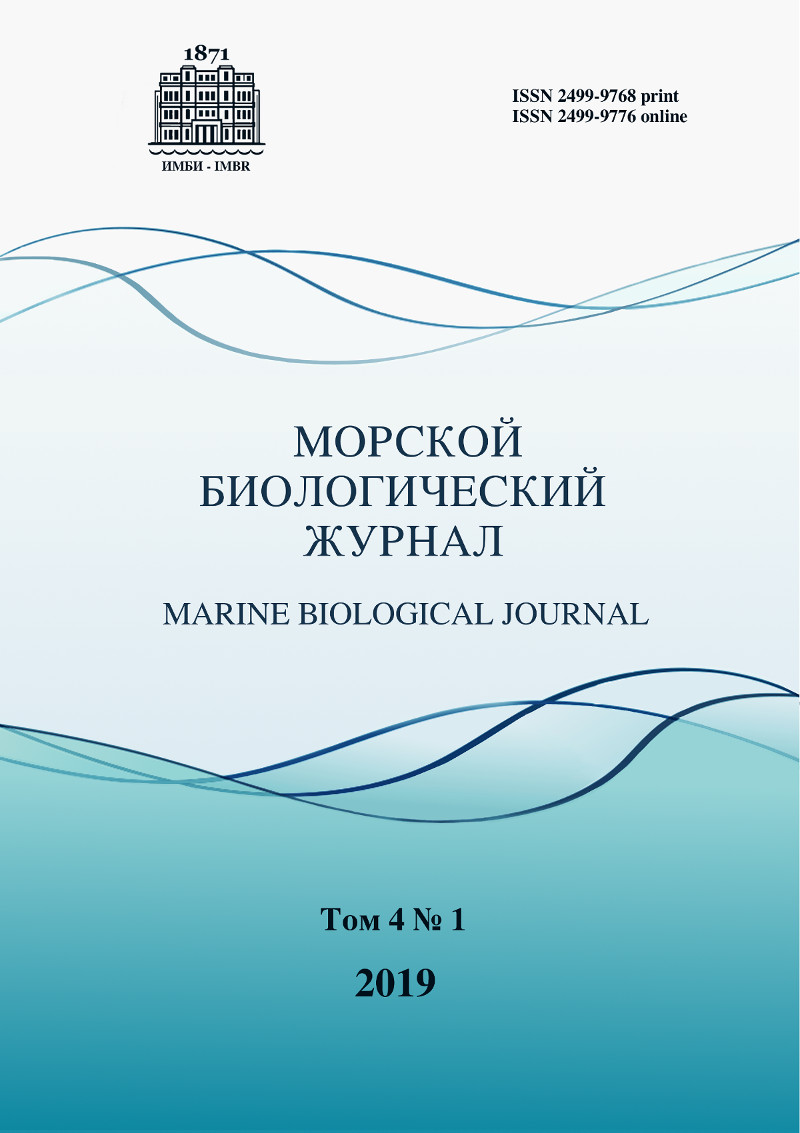Cell types diversity of H4 haplotype Placozoa sp.
##plugins.themes.ibsscustom.article.main##
##plugins.themes.ibsscustom.article.details##
Abstract
Placozoa is one of the five basal metazoan lineages critical for our understanding of animal evolution in general, and the origin of neuromuscular organization in particular. All Placozoa have the simplest known animal body plan, without neurons and muscles, but relatively complex behaviors. Totally 19 haplotypes of placozoans have been identified including two genera, Trichoplax adhaerens (H1) and Hoilungia hongkongensis (H13), plus a number of less characterized ecological groups also known as H2–H19 Placozoa sp. However, microscopic anatomy had been characterized for H1 (Trichoplax adhaerens) only. Here, using scanning and confocal microscopy, we described morphological organization of H4, the haplotype similar to Hoilungia. All six basal morphological cell types have been found in H4. Nevertheless, we recognized a greater heterogeneity of cell populations (in their shape, density, mitochondrial distribution and activity) than described elsewhere for H1. This study expands our knowledge about the biology of these enigmatic groups of marine organisms.
Authors
References
Серавин Л. Н., Гудков А. В. Trichoplax adhaerens (тип Placozoa) – одно из самых примитивных многоклеточных животных. Санкт-Петербург : ТЕССА, 2005. 69 с. [Seravin L. N., Gudkov A. V. Trichoplax adhaerens (Placozoa) — odno iz samykh primitivnykh mnogokletochnykh zhivotnykh. Sankt-Petersburg: TESSA, 2005, 69 p. (in Russ.)]
Aleoshin V. V., Konstantinova A. V., Nikitin M. A., Okshtein I. L. On the genetic uniformity of the genus Trichoplax (Placozoa). Russian Journal of Genetics, 2004, vol. 40, no. 12, pp. 1423–1425. https://doi.org/10.1007/s11177-005-0015-y
Armon S., Bull M., Aranda-Diaz A., Prakash M. Ultra-fast contractions and emergent dynamics in a living active matter – the epithelium of the primitive animal Trichoplax adhaerens. Biophysical Journal, 2018, vol. 114, no. 3, pp. 649a. https://doi.org/10.1016/j.bpj.2017.11.3503
Belahbib H., Renard E., Santini S., Jourda C., Claverie J. M., Borchiellini C., Le Bivic A. New genomic data and analyses challenge the traditional vision of animal epithelium evolution. BMC Genomics, 2018, vol. 19, no. 1, pp. 393. https://doi.org/10.1186/s12864-018-4715-9
DeSalle R., Schierwater B. Key Transitions in Animal Evolution / DeSalle R., Schierwater B. (Eds). Boka Raton, FL: CRC Press, 2010, 446 p.
Eitel M., Schierwater B. The phylogeography of the Placozoa suggests a taxon rich phylum in tropical and subtropical waters. Molecular Ecology, 2010, vol. 19, no. 11, pp. 2315–2327. https://doi.org/10.1111/j.1365-294X.2010.04617.x
Eitel M., Guidi L., Hadrys H., Balsamo M., Schierwater B. New insights into placozoan sexual reproduction and development. PLoS One, 2011, vol. 6, no. 5, pp. e19639. https://doi.org/10.1371/journal.pone.0019639
Eitel M., Osigus H. J., DeSalle R., Schierwater B. Global diversity of the Placozoa. PLoS One, 2013, vol. 8, no. 4, pp. e57131. https://doi.org/10.1371/journal.pone.0057131
Eitel M., Francis W. R., Varoqueaux F., Daraspe J., Osigus H. J., Krebs S., Vargas S., Blum H., Williams G. A., Schierwater B., Wörheide G. Comparative genomics and the nature of placozoan species. PloS Biology, 2018, vol. 16, no. 7, pp. e2005359. https://doi.org/10.1371/journal.pbio.2005359
Grell K. G. Trichoplax adhaerens F. E. Schulze und die entstehung der Metazoen. Naturwissenschaftliche Rundschau, 1971, vol. 24, pp. 160–161.
Grell K. G., Benwitz G. Die Ultrastruktur von Trichoplax adhaerens F. E. Schulze. Cytobiologie, 1971, vol. 4, pp. 216–240.
Grell K. G. Eibildung und furchung von Trichoplax adhaerens F. E. Schulze (Placozoa). Zoomorphology, 1972, vol. 73, no. 4, pp. 297–314. https://doi.org/10.1007/BF00391925
Grell K. G., Benwitz G. Elektronenmikroskopische beobachtungen über das wachstum der eizelle und die bildung der „befruchtungsmembran” von Trichoplax adhaerens F. E. Schulze (Placozoa). Zoomorphology, 1974, vol. 79, no. 4, pp. 295–310. https://doi.org/10.1007/BF00277511
Grell K. G., Ruthmann A. Placozoa. In: Microscopic Anatomy of Invertebrates / F. W. Harrison and J. A. Westfall (Eds). New York: Wiley-Liss, 1991, pp. 13–27.
Laumer C. E., Gruber-Vodicka H., Hadfield M. G., Pearse V. B., Riesgo A., Marioni J. C., Giribet G. Support for a clade of Placozoa and Cnidaria in genes with minimal compositional bias. eLife, 2018, vol. 7, pp. e36278. https://doi.org/10.7554/eLife.36278
Mayorova T. D., Smith C. L., Hammar K., Winters C. A., Pivovarova N. B., Aronova M. A., Leapman R. D., Reese T. S. Cells containing aragonite crystals mediate responses to gravity in Trichoplax adhaerens (Placozoa), an animal lacking neurons and synapses. PloS One, 2018, vol. 13, no. 1, pp. e0190905. https://doi.org/10.1371/journal.pone.0190905
Moroz L. L. The genealogy of genealogy of neurons. Communicative & Integrative Biology, 2014, vol. 7, no. 6, pp. e993269. https://doi.org/10.4161/19420889.2014.993269
Moroz L. L. NeuroSystematics and Periodic System of Neurons: Model vs Reference Species at Single-Cell Resolution. ACS Chemical Neuroscience, 2018, vol. 9, pp. 1884−1903. https://doi.org/10.1021/acschemneuro.8b00100
Schierwater B. My favorite animal, Trichoplax adhaerens. BioEssays, 2005, vol. 27, pp. 1294–1302. https://doi.org/10.1002/bies.20320
Schierwater B., De Salle R. Placozoa. Current Biology, 2018, vol. 28, iss. 3, pp. R97–R98.
Schulze F. E. Trichoplax adhaerens, nov. gen., nov. spec. Zoologischer Anzeiger, 1883, vol. 6, pp. 92–97.
Signorovitch A. Y., Dellaporta S. L., Buss L. W. Caribbean placozoan phylogeography. Biological Bulletin, 2006, vol. 211, iss. 2, pp. 149–156. https://doi.org/10.2307/4134589
Smith C. L., Pivovarova N., Reese T. S. Coordinated feeding behavior in Trichoplax, an animal without synapses. PLoS One, 2015, vol. 10, no. 9, pp. e0136098. https://doi.org/10.1371/journal.pone.0136098
Smith C. L., Varoqueaux F., Kittelmann M., Azzam R. N., Cooper B., Winters C. A., Eitel M., Fasshauer D., Reese T. S. Novel cell types, neurosecretory cells, and body plan of the early-diverging metazoan Trichoplax adhaerens. Current Biology, 2014, vol. 24, no. 14, pp. 1565–1572. https://doi.org/10.1016/j.cub.2014.05.046
Telford M. J., Moroz L. L., Halanych K. M. Evolution: A sisterly dispute. Nature, 2016, vol. 529, no. 7586, pp. 286. http://doi.org/10.1038/529286a
Voigt O., Collins A. G., Pearse V. B., Pearse J. S., Ender A., Hadrys H., Schierwater B. Placozoa – no longer a phylum of one. Current Biology, 2004, vol. 14, iss. 22, pp. R944–R945. https://doi.org/10.1016/j.cub.2004.10.036


 Google Scholar
Google Scholar



